| Pages:
1
2 |
Yaron Naor
Oud Junkie
    
Posts: 275
Registered: 1-24-2009
Location: Bat Hefer, Israel
Member Is Offline
Mood: Happy
|
|
Repairing a "Nahhat" oud
Hi All,
Yair Dalal, a famous oud player in Israel asked me to repair his "Nahhat" oud (more than 50 years old)
Here is some images of the oud, a very nice one! (gut strings still on!)
I have learned a lot from jdowning's work and from others here in the forum and I thank YOU all,
I will update from time to time with the progress
If you have any advice, comment - please do
Does any one can translate the ticket? and to recognize the wood?
Enjoy!
Yaron Naor
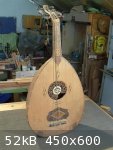
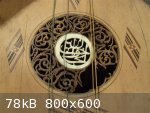
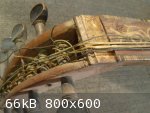
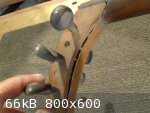
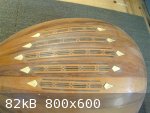
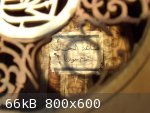
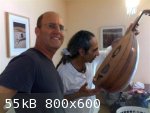
|
|
|
BaniYazid
Oud Junkie
    
Posts: 225
Registered: 8-20-2010
Location: France
Member Is Offline
|
|
Hi,
I would translate it: nahat manufacturing - Syria
I don't know how to translate the word "Sham"
For the rosette it's too hard for my basic Arabic knowledge
Have fun
|
|
|
jdowning
Oud Junkie
    
Posts: 3485
Registered: 8-2-2006
Location: Ontario, Canada
Member Is Offline
Mood: No Mood
|
|
Yaron - those 'gut' strings cannot be reused but may be of considerable interest historically even if only dating from the early
20th C (?). They should all be carefully preserved - as they are now - so that they might eventually be examined in greater detail and information
about them recorded and published for future benefit of researchers in the field of early strings and for the historical string makers active today
who may have an interest in replicating them.
In the meantime - if possible - some detailed close up images of the strings would be of great interest as well as some description (for example,
vibrating string length, string diameter, course location of each string - first , second, third etc). Are the dark coloured strings overwound with
metal wire (silver?) similar to modern bass strings? If so the core material may either be silk filament or gut.
Thanks
|
|
|
conroystoptime
Oud Maniac
   
Posts: 59
Registered: 2-22-2012
Member Is Offline
|
|
"Sham" is a local nickname for Damascus.
|
|
|
suz_i_dil
Oud Junkie
    
Posts: 1064
Registered: 1-10-2008
Member Is Offline
Mood: No Mood
|
|
The rosette calligraphy is اخوان نحات (Nahat brothers).
It seems to be a nice oud, so good luck for this restauration.
|
|
|
Yaron Naor
Oud Junkie
    
Posts: 275
Registered: 1-24-2009
Location: Bat Hefer, Israel
Member Is Offline
Mood: Happy
|
|
Quote: Originally posted by jdowning  | Yaron - those 'gut' strings cannot be reused but may be of considerable interest historically even if only dating from the early
20th C (?). They should all be carefully preserved - as they are now - so that they might eventually be examined in greater detail and information
about them recorded and published for future benefit of researchers in the field of early strings and for the historical string makers active today
who may have an interest in replicating them.
In the meantime - if possible - some detailed close up images of the strings would be of great interest as well as some description (for example,
vibrating string length, string diameter, course location of each string - first , second, third etc). Are the dark coloured strings overwound with
metal wire (silver?) similar to modern bass strings? If so the core material may either be silk filament or gut.
Thanks |
Thank you all for the info!
Dear jdowning, do you want me to send you the strings?
and I will send you all the images, info, and bracing pattern etc.?
Mail my private mail for your address info.
Take care
Yaron Naor
|
|
|
Alfaraby
Oud Junkie
    
Posts: 796
Registered: 9-18-2009
Location: Holy Land
Member Is Offline
Mood: Cool
|
|
Excuse me, but I have some observations to make :
There has never been a label saying "Nahat, Damascus, Syria". Nahat is the family name of 6 different luthiers, who worked between 1880-1965
in Damascus; and another one, who worked in Brazil between 1967-1984-5.
More about Nahat in Brazil see here: http://www.mikeouds.com/messageboard/viewthread.php?tid=9897
Nahat Bro. partnership was liquidated 100 years ago, back in the 1910's. Some rosettes of Nahat Bro. were seen on other Nahat's later on, but the
label indicated who was the luthier.
More about Nahat legacy, you'd find here: http://www.droud.com/Nahhat.html
50 years ago, back in the sixties, there was only one active Nahat luthier in Damascus: George Hanna Nahat.
G.H.N used different labels, as seen here in the forum, all carrying his own photo, none of which was as seen in the above photos.
More about GHN labels you can find here : http://www.mikeouds.com/messageboard/viewthread.php?tid=8370#pid539...
It might be an old oud. It seems very nice though, and it might be a very good Nahat as well, but the label made me think it is not ! Well ... maybe.
Yours indeed,
Alfaraby
alfarabymusic@gmail.com
|
|
|
Yaron Naor
Oud Junkie
    
Posts: 275
Registered: 1-24-2009
Location: Bat Hefer, Israel
Member Is Offline
Mood: Happy
|
|
Quote: Originally posted by Alfaraby  | Excuse me, but I have some observations to make :
There has never been a label saying "Nahat, Damascus, Syria". Nahat is the family name of 6 different luthiers, who worked between 1880-1965
in Damascus; and another one, who worked in Brazil between 1967-1984-5.
More about Nahat in Brazil see here: http://www.mikeouds.com/messageboard/viewthread.php?tid=9897
Nahat Bro. partnership was liquidated 100 years ago, back in the 1910's. Some rosettes of Nahat Bro. were seen on other Nahat's later on, but the
label indicated who was the luthier.
More about Nahat legacy, you'd find here: http://www.droud.com/Nahhat.html
50 years ago, back in the sixties, there was only one active Nahat luthier in Damascus: George Hanna Nahat.
G.H.N used different labels, as seen here in the forum, all carrying his own photo, none of which was as seen in the above photos.
More about GHN labels you can find here : http://www.mikeouds.com/messageboard/viewthread.php?tid=8370#pid539...
It might be an old oud. It seems very nice though, and it might be a very good Nahat as well, but the label made me think it is not ! Well ... maybe.
Yours indeed,
Alfaraby |
Thanks for you knowledge and comments!
I really don't know and there is no date on it (-:
Maybe you right, maybe not
The instrument is very old, very good built, and I will make him play...
Regards
Yaron.
|
|
|
jdowning
Oud Junkie
    
Posts: 3485
Registered: 8-2-2006
Location: Ontario, Canada
Member Is Offline
Mood: No Mood
|
|
Hi Yaron - thank you for your kind offer about the strings etc. I would be happy to examine the strings and then publish a freely available report on
them for the information of all luthiers, worldwide, who might be interested. I can then return the strings to you if you so wish.
Be sure to save even the broken string fragments that may remain attached to the pegs as they also can reveal important information.
Of course the original maker of the oud is not so much an important consideration regarding the strings.
I shall contact later today you via email with my mailing address details and other information.
Thanks again.
John
|
|
|
Yaron Naor
Oud Junkie
    
Posts: 275
Registered: 1-24-2009
Location: Bat Hefer, Israel
Member Is Offline
Mood: Happy
|
|
Dear John,
The package has left the post office,
Here is some progress:
1. Rebuilding the pegbox
2. Repairing the fingerboard
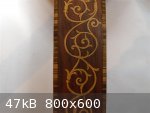
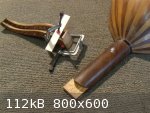
|
|
|
jdowning
Oud Junkie
    
Posts: 3485
Registered: 8-2-2006
Location: Ontario, Canada
Member Is Offline
Mood: No Mood
|
|
Thanks Yaron - I look forward to examining and reporting on the strings.
|
|
|
Yaron Naor
Oud Junkie
    
Posts: 275
Registered: 1-24-2009
Location: Bat Hefer, Israel
Member Is Offline
Mood: Happy
|
|
More progress...
I finished the cracks repair and the neck/pegbox, finished the retouching of the nice ornaments and starts with the Shellac
Yaron.
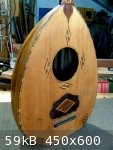
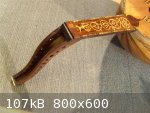
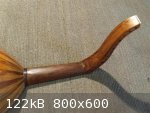
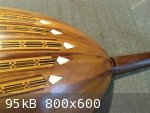
|
|
|
jdowning
Oud Junkie
    
Posts: 3485
Registered: 8-2-2006
Location: Ontario, Canada
Member Is Offline
Mood: No Mood
|
|
Hi Yaron - just to let you know that the strings and drawing have arrived safely thank you. Please thank owner Yair Dalal for allowing the strings to
be borrowed for examination. I shall return them to you on completion of the inspection.
I shall post the results of the string examination as a report in Pdf format as well as a Pdf report on a geometrical analysis of the oud profile -
for comparison with the geometry of other Nahats.
|
|
|
Yaron Naor
Oud Junkie
    
Posts: 275
Registered: 1-24-2009
Location: Bat Hefer, Israel
Member Is Offline
Mood: Happy
|
|
Quote: Originally posted by jdowning  | Hi Yaron - just to let you know that the strings and drawing have arrived safely thank you. Please thank owner Yair Dalal for allowing the strings to
be borrowed for examination. I shall return them to you on completion of the inspection.
I shall post the results of the string examination as a report in Pdf format as well as a Pdf report on a geometrical analysis of the oud profile -
for comparison with the geometry of other Nahats. |
With pleasure John!
If you need any other measurement or info about that oud, please let me know and I will send it to you
Looking forword for your report...
Regards,
Yaron.
|
|
|
jdowning
Oud Junkie
    
Posts: 3485
Registered: 8-2-2006
Location: Ontario, Canada
Member Is Offline
Mood: No Mood
|
|
The treble strings are plain gut and the basses round metal wire overspun on a filament core.
From a preliminary examination of the metal wound string fragments I can confirm that the core material is silk filament wound with copper wire that
appears to have originally been electroplated with silver(?). Electroplated wire would likely have been available to the jewellery trade after about
1857 and nylon instrument strings were first developed around 1947 for the classical guitar by Albert Augustine in cooperation with the DuPont
chemical company - coming into general use during the 1950's.
Hard to say for sure but this would date the strings to anywhere between say the late 19th C and mid 20th C - say, around 1965 to allow for remaining
'old' stocks of gut trebles and silk core bass strings to be used up. Note that I was able to purchase a set of French made gut oud strings in Cairo
as late as 1964 - but that was at the time of the 'post Suez' crisis (revolution) in Egypt where a lot of imported stuff was difficult to obtain at
any price. Therefore, the oud was made somewhere within that time frame so the reported age of the oud of about 50 years would seem reasonable.
It would seem that the oud has never been fitted with or played with modern nylon strings. It would be interesting, therefore, to refit the oud after
restoration with replica gut and metal on silk basses - strings that may be obtained from some of the modern historical string makers.
The string inspection report should, hopefully, provide sufficient data that will allow specification of a set of replica strings.
(Edited - June 26)
|
|
|
jdowning
Oud Junkie
    
Posts: 3485
Registered: 8-2-2006
Location: Ontario, Canada
Member Is Offline
Mood: No Mood
|
|
Here attached is a preliminary report on the examination of the old oud strings.
These are to be returned to to Yaron so please feel free to ask any questions about the strings while they are still in my hands.
Gut strings likely went quickly out of popularity during the 1960's as nylon strings became increasingly readily available but hopefully there are
still a few surviving strings tucked away in attics or cupboards somewhere gathering dust. If you know of any please let us all know before they and
the information that they might hold are lost forever.
Attachment: Inspection Report Early 20th C Gut Strings.pdf (463kB)
This file has been downloaded 549 times
|
|
|
jdowning
Oud Junkie
    
Posts: 3485
Registered: 8-2-2006
Location: Ontario, Canada
Member Is Offline
Mood: No Mood
|
|
In addition to mailing the old strings for analysis, Yaron kindly provided a full size tracing of the oud profile which has enabled a fairly precise
geometrical analysis of the oud design. What this has confirmed is that the design of the oud is based upon a Pythagorean 3:4:5 right triangle
constructed using only a pair of dividers and a straight edge (not a ruler) and unit of desired dimension. This is how the old lutes and ouds were
designed. (See ' Old Oud Compared to Old Lute Geometry' on this forum).
The selected unit size for this example of an old Syrian oud may originally have been based upon the ancient 'finger' measure that ranged in length
from about 1.85 cm (Egyptian) to about 2.28 cm (Persian). The former measure is derived from the Egyptian Royal cubit of about 52.5 cm and the latter
measure is said to be derived from the ancient Persian cubit of about 63.8 cm each having 28 'fingers' to the cubit (according to those who have
studied ancient metrology).
For this size of oud, the measured unit dimension is equal to about 9.25 cm ± 0.5 mm. Dividing by 4 gives a dimension range of 2.3 cm to 2.33 cm.
Dividing by 5 gives a dimension range of 1.84 cm to 1.86 cm. This is a very interesting result given that the lengths are so close to both the ancient
Egyptian 'finger' unit or the ancient Persian 'finger' unit. As well it suggests that both ancient standards were connected by the ratio 4:5.
From preliminary studies of other Nahhat ouds derived - much less accurately from photographic images - the geometry of this oud - based upon the
Pythagorean triangle - is consistent with a system also used by the Nahhat family.
The attached image shows the basic geometry which is drawn proportionally to scale based upon an arbitrary unit (four squares = 1 unit). To avoid
going into great detail I hope that the construction is clear enough as it stands.
The starting point for the geometrical construction is a 3:4:5 Pythagorean right triangle XYZ side XZ being equal to 1 unit measurement (here further
divided into 4 sub units)
Essentially the profile of the oud is a pseudo ellipse constructed by blending the arcs of a circle as indicated.
The upper sound board profile is an arc of 5 units radius centre G modified at the upper part with an arc of 3 units radius centre F.
The lower sound board profile is a blend of three arcs of radius 1 unit, 2 units and 51/2 units.
The front edge of the bridge tie block is one unit from the bottom of the sound board H.
Brace #2 at C is 4 units from H (where arc of radius CG is 4 units).
Brace #4 is at E where distance CD = DE.
The front edge of the neck block B is 5 units from H.
Point A is 5 units from X. XGA is a 3:4:5 Pythagorean right triangle.
The neck joint position is determined by the required fingerboard width (here to accommodate six double courses) the fingerboard length is then equal
to the distance from neck joint to D the sound hole centre.
The sound hole diameter is equal to the 'long side' of the basic 3:4:5 right triangle YZ.
Edited July 01
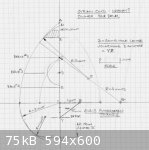
|
|
|
jdowning
Oud Junkie
    
Posts: 3485
Registered: 8-2-2006
Location: Ontario, Canada
Member Is Offline
Mood: No Mood
|
|
Yaron has also marked the brace positions on the full size drawing of the oud enabling an analysis of the brace geometry.
Although the braces are not set perfectly perpendicular to the vertical axis of the oud (they slope slightly), the attached sketch of the proposed
geometry based upon perfect alignment is still within a millimeter or two. As with the geometry of the oud profile, the geometry of the bracing is
determined proportionally using only dividers.
The bracing geometry is related only to the vibrating part of the sound board - i.e. from the inside edge of the neck block to the bottom of the bowl.
The position of the first and second braces is determined by the intersection of circular arcs with the vertical Y axis. The position of the remainder
of the braces is then determined with reference to the sound hole centre and the horizontal X axis as indicated in the attached sketch. So braces #2
and #3 are equi-distant from brace #3, braces #4 and #5 are equi-distant from brace #5 and braces #6 and #7 are equi- distant from the front edge of
the bridge. All rather straightforward really!
Note that the bracing geometry is related to the bridge design referencing the front edge of the bridge rather than only the front edge of the tie
block. This style of bridge is used by the Nahat luthiers.
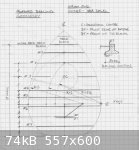
|
|
|
abusin
Oud Junkie
    
Posts: 442
Registered: 3-23-2006
Location: Manchester England
Member Is Offline
Mood: Ya Fuadi La Tasal
|
|
  
Good job Yaron, can't wait to hear it 
John thanks for the analysis, very educational 
Best Regards
Awad
|
|
|
jdowning
Oud Junkie
    
Posts: 3485
Registered: 8-2-2006
Location: Ontario, Canada
Member Is Offline
Mood: No Mood
|
|
Just to add some further comment.
According to Yaron's full size drawing of the oud there is some asymmetry about both the vertical and horizontal axes and the neck is canted over to
the bass side by about 5 mm based upon a vertical centre line drawn through the sound hole centre. Working with this assumed centre line, the profile
of the sound board is not symmetrical - the curve of the upper profile being different on the bass and treble side. However if a new reference
vertical centreline is created by dividing the sound board equally down the middle and a new horizontal axis is drawn perpendicular to the vertical,
then the symmetry of the profile is perfect. What seems have occurred is that when the sound board was originally fitted and glued in place it did not
conform exactly to the vertical centre line but was offset about 3 mm or so to the bass side. Furthermore the neck may have been removed at some later
date for adjustment and then incorrectly set out of perfect alignment.
This slight lack of perfect symmetry is found in some of the old surviving lutes made by the master luthiers of their day and no doubt the same
situation applies to the surviving old ouds.
The interesting thing about this oud is that both the sound board profile (and sound hole centre, sound hole diameter and bridge placement) as well as
the bracing layout appear to have been designed from 'first principles' using dividers and straightedge (the proportions of the design are so close
and consistent). So it would seem unlikely that the oud might be just a slavish copy by a luthier who otherwise had no knowledge of the traditional
design proportions of an oud.
Note also that although the fingerboard length is equal to the distance from neck joint to sound hole centre (within a mm) the distance from sound
hole centre to the bridge tie block is somewhat greater - so the often quoted 'rule' that these dimensions should all be equal does not apply in this
case.
|
|
|
Yaron Naor
Oud Junkie
    
Posts: 275
Registered: 1-24-2009
Location: Bat Hefer, Israel
Member Is Offline
Mood: Happy
|
|
Thank you so much john for a wonderful job and knowledge!
I finished the rosette restoration, tried to use all the genuine parts and less new wood, as much as the original look and feel
Thanks,
Yaron Naor

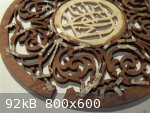
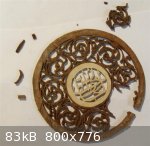
|
|
|
Alfaraby
Oud Junkie
    
Posts: 796
Registered: 9-18-2009
Location: Holy Land
Member Is Offline
Mood: Cool
|
|
Nahat or not, never mind, a great job Yaron !
Waiting to hear the bridegroom 
Yours indeed
Alfaraby
alfarabymusic@gmail.com
|
|
|
excentrik
Oud Junkie
    
Posts: 291
Registered: 5-19-2004
Location: Refugee Status...
Member Is Offline
Mood: Now Here, Nowhere...
|
|
Any updates?
-Tarik
|
|
|
Yaron Naor
Oud Junkie
    
Posts: 275
Registered: 1-24-2009
Location: Bat Hefer, Israel
Member Is Offline
Mood: Happy
|
|
Some updates...
Rosette is set, now I am refurbishing the pegs and putting the strings on.
Thanks.
Yaron Naor
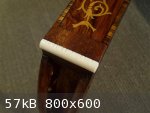
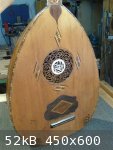
|
|
|
Yaron Naor
Oud Junkie
    
Posts: 275
Registered: 1-24-2009
Location: Bat Hefer, Israel
Member Is Offline
Mood: Happy
|
|
Finished!!!
This amazing project is finished 120h of detailed restoration
Lots of love and passion
The sound is amazing! as soon as Yair Dalal will come to pickup the oud I will record it...
Thank you all for your kind feedbacks and comments
Big thanks to our expert in Canada, Mr. J. downing for all the knowledge and sharing.
Yaron Naor
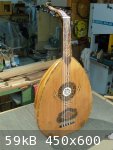
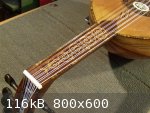
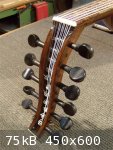
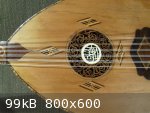
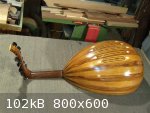
|
|
|
| Pages:
1
2 |